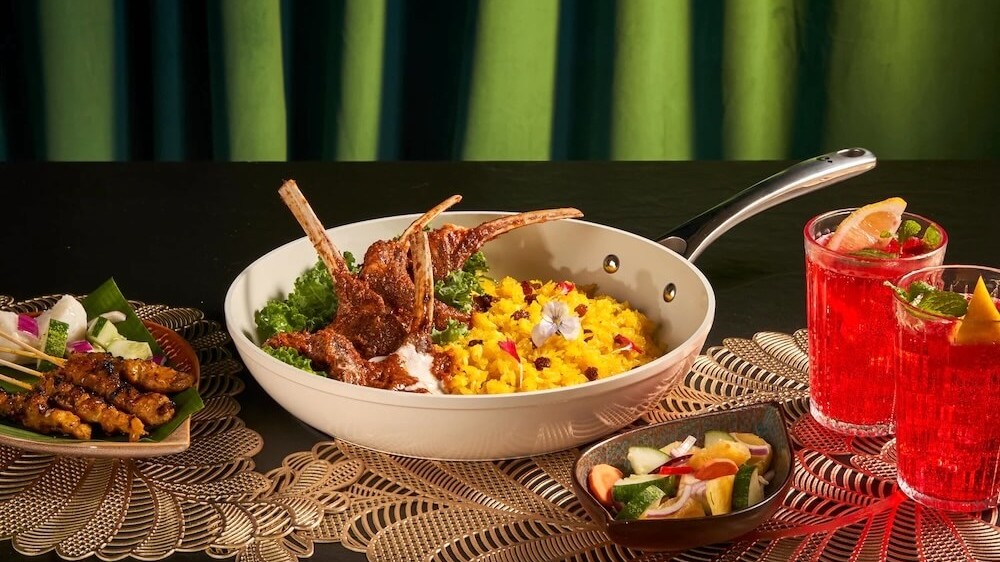Savour The Aromatic Richness Of Rendang With This Easy One-Pot Lamb Rendang Recipe
Aromatic and rich with a delightfully spicy kick. That’s right folks, it’s none other than rendang. This signature Malaysian and Indonesian stew is truly a beloved dish of Southeast Asia thanks to its complex flavours coupled with tender, succulent meat that goes deliciously over plain white rice.
Fun Fact: Did you know that Rendang was voted as one of the world’s 50 best foods by CNN in 2017 and 2021?
Rendang has long been thought of as a complicated dish to recreate in the kitchens of regular homecooks. But it actually isn’t complicated to make!
True it does involve an extended process, but then again, is there truly a recipe that didn’t involve one that came out mind-blowingly delicious?
Whether you’re a beginner home cook or a veteran in the kitchen, our step-by-step process for an authentic Malaysian lamb rendang is an easy one that even beginner cooks find simple to recreate in their home kitchen.
But before we get started on cooking, let’s get to know this iconic Southeast Asian dish a little more intimately because (trust me on this) the preparation and cooking process will make that much more sense once you’re familiar with the ins and outs of the ever delicious rendang!
Where Did Rendang Originate From?
Rendang is strongly believed to have originated from the Minangkabau people of West Sumatra in Indonesia. This rich, flavourful dish was traditionally prepared only for ceremonial occasions such as Hari Raya (Eid), birthdays, marriages, and celebrations to honour guests due to the length of time, care, and patience required in its cooking process.
Modern kitchen appliances have made the process to cook rendang a much easier one. But back then, the process to cook rendang involved slow-cooking meat (typically beef or chicken) in a blend of spices and coconut milk until the coconut milk is fully absorbed and the meat is dark and caramelised for a drier, darker dish with intense flavours.
This made it a boon during olden times before the advent of the refrigerator, because the rendang’s ingredients and cooking process naturally preserved the dish to last up to 4 weeks. This made it ideal for merchants and traders of West Sumatra who regularly embarked on long trade journeys, which scholars believe was how knowledge of the dish is said to have spread throughout Indonesia and Malaysia.
Today, rendang is a local staple for Malays in both Indonesia and Malaysia where it is enjoyed as part of their daily fare, while also being a highlight during festive periods.
What Are The Differences Between Malaysian Rendang And Indonesian Rendang?
A quick search online and you may find that there’s a debate over whether rendang is a Malaysian dish or an Indonesian dish. I daresay that rendang is actually a Southeast Asian dish even though it originally hailed from Indonesia.
That’s because both countries have effectively adopted it as part of their local heritage and cuisine, with each country featuring their own version of rendang.

For instance, Indonesian rendang is typically cooked for a longer duration where the coconut milk is fully absorbed, and the meat is dark and caramelised. What you’ll ultimately get is a drier, darker dish with intense flavours and an almost crumbly texture when it comes to the Indonesian rendang.
Whereas Malaysian rendang has kerisik (toasted grated coconut) added into it over the cooking process and is cooked for a shorter period. This results in a dish that retains a rich, gravy-like consistency with a uniquely spicy and nutty flavour in every creamy bite.

The Malaysian version is ultimately a more moist and creamy dish compared to its Indonesian counterpart, which is drier but more intense in flavours.
And for what it's worth, rendang is not crispy.
How Is Rendang Different From Curry?
Something a lot of people (and I mean A LOT) ask about rendang, is how it differs from curry. I mean, it’s spicy, commonly found in the form of a stew, has an intoxicating aroma, and they both use coconut milk. So what’s the difference?
For starters, rendang and curry each have their own cooking method. Rendang is traditionally slow-cooked and reduced to intensify its flavours. Whereas curries are generally cooked for a shorter period in stock and water, so you’ll be looking at a watery dish with more gravy or sauce.
Second, the ingredients for rendang and curry are also different. Rendang typically uses fresh spices and aromatics which are processed into a paste either via pounding or through a food processor, while curries utilise a mixture of ground herbs and spices that sometimes involve curry powder depending on the recipe.

The next difference lies in their texture and consistency. Rendang is often drier than curries, so instead of a gravy or sauce, what you’ll get is a dense, flavourful paste. Curry on the other hand, has more liquid which may be watery or thick, but definitely not dry.
The flavours of rendang and curry are also miles apart. The prolonged cooking time of rendang usually results in an intense, concentrated flavour of spices, kerisik, and the aromatics used. But curries vary depending on the region and ingredients used, so it can be spicy, sweet, tangy, or savoury.
Lastly, we have the cultural differences between rendang and curry. Rending’s heritage lies in its origin as a ceremonial dish of the Minangkabau culture in Indonesia, while curry is a more ubiquitous dish found in everyday meals across various cultures. Even though there are two versions of rendang, they are still highly similar. But when it comes to curries, you’ll find that every culture has their own way to prepare it with ingredients unique to their region.
What Is Rendang Sauce Made Of?
Rendang sauce is rich with a complex depth of flavours because the mixture of herbs and spices that go into making its base spice paste is equally eclectic. These are the rendang sauce’s core ingredients:

1. Coconut Milk
Coconut milk serves as an essential creamy base for the rendang sauce. It adds a layer of natural sweetness and nuttiness while giving the sauce a rich consistency.

2. Spice Paste Ingredients
The rendang’s spice paste mix serves as the aromatic base for rendang. It typically consists of dried red chilies, shallots, garlic, ginger, galangal, lemongrass, turmeric, tamarind, and kaffir lime leaves.
This combination gives the rendang sauce its signature spicy sweetness while adding a level of earthiness with a hint of citrusy aroma from the lemongrass and kaffir lime leaves. It also serves as a natural preservative for the meat upon cooking.
Traditionally, these ingredients are chopped or sliced, then pounded in mortar with a pestle until it turns into a paste. This particular process is incredibly time consuming and laborious, but it fully releases the aroma and natural oils of the ingredients, making it exceptionally strong.
However this laborious method has long been traded for the convenience of a food processor in modern recipes. You’ll still get the strong aroma and flavours, but the strength of the aromatics won’t be as heavily pungent as the traditional method, which some may prefer.
Fun Fact: Some traditional recipes call for fresh turmeric to be used in the spice paste, but turmeric powder works just as well!
3. Kerisik (Toasted Grated Coconut)
Here’s where most of us get caught. Kerisik is simply pounded grated coconut flesh that has been toasted, which adds a nutty flavour to the rendang sauce while thickening it. That said, it’s typically found only in the Malaysian version of rendang because the Indonesian rendang has none of it.

Why A Lamb Rendang Recipe When Beef And Chicken Rendang Are The Norm?
Singapore is a melting pot of various cultures, and some cultures like the Chinese and Indian cultures tend to keep away from beef due to religious reasons. Lamb serves as a tender alternative to beef, and a fun replacement to those who are bored of the usual chicken rendang.
Did we also mention that lamb is tender? When slow-cooked, lamb is one of the most tender and succulent proteins out there. What’s more is how delicious it is once it absorbs the flavours of the rendang spices and coconut milk. You’ll be looking at melt-in-your-mouth lamb with the rich flavours of rendang, and trust me when I say that’s quite simply delectable.
How Do I Ensure That The Lamb Rendang Comes Out Tender?
There are a few things to keep in mind if you want your lamb rendang to come out tender. First of which is to ensure you have the right cut of meat.
The ideal cut is usually the lamb shoulder or lamb leg because of its abundant connective tissue and fat, which allows it to become tender when slow-cooked. You’ll want to avoid cuts like lamb loin or lamb chops as they can become tough when cooked for long.

Next, it’s best to cook the lamb low and slow. This means cooking the lamb on low heat for an extended period of time. The lamb’s natural collagen will break down from the long cooking process, making it tender and succulent. You can do this by first bringing the coconut milk and spice mixture to a simmer, followed by turning the heat down to low for the rendang to cook slowly while stirring occasionally.
If you can’t get lamb shoulder or lamb leg, another fantastic alternative I love using for my stews and slow-cooked dishes is lamb chuck. You can find it in either its whole “chuck” form, sliced into chuck steak, or chopped into cubes. It tenderises easily through slow-cooking while also having a decent balance of lean and fat, making especially ideal to cook the best lamb rendang.
What If My Rendang Turns Out Too Watery?
If your rendang turns out too watery, here are some ways to thicken the rendang sauce without affecting the flavours you’re after.
For starters, you can allow the rendang to continue simmering over low heat with the lid off to evaporate the excess liquid. This is one of the best ways because it also dials up the flavours significantly for the better.
Another way is to add more kerisik, but I’m not too fond of this method because it heightens the nuttiness and sweetness of the rendang. That said, if you love the natural sweet nuttiness of coconut, this is the method for you.
A final popular method is to use a thickening agent like cornstarch. Simply mix 1-2 teaspoons of cornstarch with a small amount of room temperature water to create a slurry which you can slowly stir into the rendang mixture to thicken the sauce.
Ultimately I’d say reducing it over low heat (the first method) is the best method to naturally thicken watery rendang. If you’re worried that the meat may overcook and become dry in the process, you can always remove the meat and set it aside for the time being while allowing the sauce to reduce, and add it back into the sauce again once it’s done.




